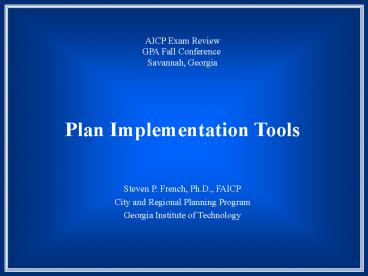Plan Implementation Tools - PowerPoint PPT Presentation
1 / 26
Title:
Plan Implementation Tools
Description:
Savannah, Georgia. Purpose of the Comprehensive Plan ... Property Tax. Sales Tax. Tax Abatement. Conservation Use Taxation. Community Improvement Districts ... – PowerPoint PPT presentation
Number of Views:73
Avg rating:3.0/5.0
Title: Plan Implementation Tools
1
AICP Exam Review GPA Fall Conference Savannah,
Georgia
Plan Implementation Tools
Steven P. French, Ph.D., FAICP City and Regional
Planning Program Georgia Institute of Technology
2
Purpose of the Comprehensive Plan
Provide a guide for individual decisions Assure
the efficient provision of public
services Protect common property
resources Limit spillover effects
(externalities) Facilitate cooperation among
competing interests Comply with state mandates
3
Implementation Techniques
Regulation Acquisition Taxation Expenditure
4
Regulation
Zoning Subdivision Environmental Impact
Analysis Housing Ordinances Sign Ordinances Tree
Ordinances Grading Ordinances Building Permits
5
Zoning
Regulatory process that controls the location
and intensity of specific land uses It is based
on the POLICE POWER
POLICE POWER is the authority of government to
regulate private actions to promote health,
safety and welfare
6
Zoning
Factors Regulated Type of Land Use Lot Size
(Density) Lot Coverage (Floor Area
Ratio) Setbacks Building Height Parking
Requirements
7
Zoning
Key Concepts Conditional Use
Permit Variance Board of Zoning
Appeals Planned Unit Development
(PUD) Floating Zone Performance
Zoning Exclusionary Zoning
8
Zoning
Legal Background
Euclid vs. Ambler Realty (1926) Petaluma
(1975) Nollan vs. Cal. Coastal Commission
(1987) First English Evangelical Lutheran
Church (1987)
9
Subdivision
Regulatory process that controls the creation
of new land parcels Based on the administrative
authority to record property plats and deeds
10
Subdivision
Factors Regulated Lot Layout and
Configuration Street and Intersection
Design Utility Easements Infrastructure
Construction Infrastructure Finance
11
20
40
60
80
100
120
140
Zoning R-1 Min. Lot Size 5000 sq. ft. Side
Setback 30 ft.
HAPPY MEADOWS SUBDIVISION
12
Environmental Impact Assessment
Analytic process that determines the impact
that a project or action will have on various
environmental systems May or may not require
that those impacts be mitigated
13
Environmental Impact Assessment
Required for all federal actions by the
National Environmental Policy Act (NEPA,
1969) Several states have similar requirements
(e.g. CEQA)
14
Environmental Impact Assessment
NEPA requires a comparison of multiple
alternatives including a no build
alternative FONSI Finding of No Significant
Impact
15
Environmental Impact Assessment
Impact D Environmental Factor with and
without proposed project
Environmental Factor (without project)
- Environmental Factor (with project)
Environmental Impact
16
Acquisition
Fee Simple Purchase Dedications Exactions Conserva
tion Easements Eminent Domain
17
Acquisition
In Kelo vs. City of New London (2005) U.S.
Supreme Court held that the city could use its
power of eminent domain for any legitimate public
purpose, including taking land for redevelopment.
18
Taxation
Property Tax Sales Tax Tax Abatement Conservation
Use Taxation Community Improvement Districts Tax
Increment Financing (TAD in GA)
19
Taxation
What is the largest source of revenue for most
local governments?
Property Tax
20
Taxation
Is an Impact Fee a tax?
No, it is a form of user fee. Projects are asked
to pay for the capital facilities needed to serve
them.
21
Expenditure
Capital Improvements Roads, Water, Sewer Storm
Sewer, Schools Police Stations, Fire Stations,
Libraries Operating Expenditures
22
Expenditure
Capital Improvements Program
Typically a rolling five or six year list
of planned capital improvement projects. Current
year moves into the annual budget and new
projects are added in the out year
23
Expenditure
Bonds
General Obligation Revenue Industrial Development
24
Budgeting
Determines Revenues and Expenditures Capital
Budgeting Planning Programming and Budgeting
Systems (PPBS) Zero Based Budgeting
(ZBB) Management by Objectives (Peter Drucker)
25
Local Revenue Sources
Property Tax Sales Tax Transient Occupancy
Tax Licenses User Fees Intergovernmental Transfers
26
Implementing Your Plan
Let comprehensive plan guide decisions Consider
the impacts of development Use the full range of
tools Look for tools that reinforce each other DO
NOT rely solely on regulation































